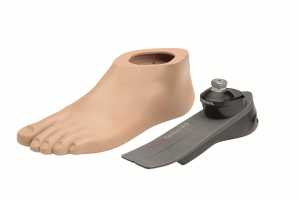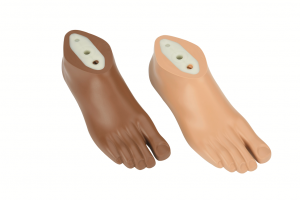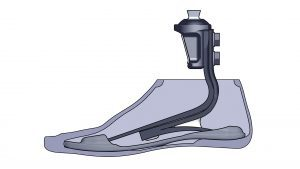The prosthetic foot: Everything you need to know
A prosthetic leg can be made of a wide range of different components. A prosthetic knee? A liner? A sleeve? Whether or not these parts are included depends on a wide range of factors. But what all prosthetic legs have in common is a prosthetic foot!
The newest prosthetic feet offer new possibilities and activities to those with a leg amputation. The right foot can help you achieve your goals. There are even special feet designed specifically for running!
The basis
The functioning of the human foot and ankle is complex, which makes it challenging to design a good prosthetic foot.
Ideally, a prosthetic foot is lightweight. After all, apart from the weight of the foot, it also has to carry the weight of the rest of your prosthetic leg. If the foot is too heavy, it can compromise the suspension system and, consequently, the connection between the socket and residual limb.
A good prosthetic foot must also be strong because it needs to absorb significant forces and turn when you walk. The foot must also be small enough to fit into a foot cover. And this foot cover, in turn, must fit into your shoe. Lightweight, strong and small, yet functional and durable: that's the challenge.
In the past, prosthetic feet were often made of a piece of wood. There are still feet available that resemble this "original model"! These often have a rigid inside (of wood or plastic) that is covered with a foam foot cover. Due to their ruggedness, these prosthetic feet are still used quite often.
But prosthetic development has, of course, continued. The more sophisticated prosthetic feet offer more functions that are hidden in a cosmetic foot cover. Most people never see their prosthetic foot without this outer cover. The foot cover serves two important functions: it helps your prosthetic foot look like a "regular" foot and it fills the space in your shoe.

Materials
The material used to make your prosthetic foot depends on your activity level. For less active people who require considerable stability, the foot is often made of wood, plastic and foam. Do you lead a very active life? Then a carbon foot is probably a better choice for you. Carbon provides greater shock absorption and is very lightweight.
Function
A prosthetic foot is designed to imitate the human foot function. For those who are unable to walk, the function of the prosthetic foot is primarily cosmetic, so the foot should look like a "real" foot. For active users, the prosthetic foot should imitate a foot when walking. The foot needs to absorb shocks when you place your heel on the ground, adapt to an uneven surface and ensure a smooth heel-to-toe gait. The foot also serves as a sort of lever: it needs to push you forward at the end of each step.
Flexible movement
Some prosthetic feet are designed to imitate the ankle. This makes it possible to move the foot in several directions. With a prosthetic foot with several axes, you can lift and lower the forefoot, move the forefoot to the left and right and roll the foot slightly inwards and outwards. This type of movement is necessary to walk comfortably and with confidence on uneven terrain because your foot needs to continuously adapt to the surface.
Energy storage
A foot made of carbon for energy storage literally puts a spring in your step. The carbon functions like a spring: it compresses when weight is put on it and thrusts you forward at toe-off. As a result, your prosthetic foot releases energy when the spring is released. Some prosthetic feet have a spring in the heel and a second spring in the forefoot, depending on what you need to walk at different paces, run, climb hills or descend stairs. And, as far as carbon is concerned, the longer the spring, the more energy it can store and the more sensitive the foot will be.

